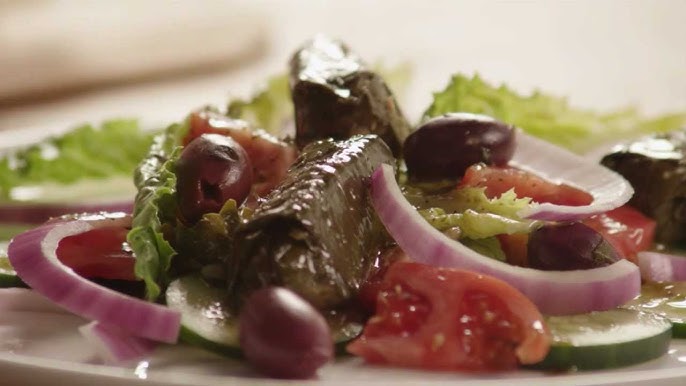Greek Vinaigrette Recipe: Greek vinaigrette is more than just a salad dressing—it’s a flavor-packed staple of the Mediterranean diet that brings freshness and zest to almost any dish. Unlike heavy cream-based dressings, this vinaigrette relies on the natural richness of olive oil, the tanginess of vinegar, and the earthiness of herbs. When combined, these ingredients create a dressing that’s not only delicious but also versatile. You can drizzle it over crisp Greek salads, roasted vegetables, grilled chicken, or even use it as a marinade for fish.
What makes Greek vinaigrette truly special is its balance of flavors. The acidity from red wine vinegar or lemon juice cuts through the richness of olive oil, while oregano, garlic, and mustard add depth and complexity. This harmony of simple ingredients is why it has stood the test of time in Greek kitchens.
Imagine the sunshine-filled Mediterranean coast, where meals are made with fresh produce, healthy oils, and herbs straight from the garden. That’s the essence of Greek vinaigrette—it captures the Mediterranean lifestyle in a single jar. It’s not just a dressing; it’s a celebration of fresh, wholesome eating.
Health Benefits of Greek Vinaigrette
One of the biggest reasons Greek vinaigrette is beloved worldwide is because it’s as healthy as it is flavorful. Unlike many store-bought dressings loaded with sugar, preservatives, and low-quality oils, a homemade Greek vinaigrette is clean and nutritious.
Key health benefits include:
- Olive Oil: Extra virgin olive oil is rich in monounsaturated fats, which help reduce bad cholesterol and support heart health. It’s also packed with antioxidants that fight inflammation and promote longevity.
- Vinegar or Lemon Juice: These add not just tangy flavor but also aid in digestion and help regulate blood sugar levels.
- Garlic: Known for its immune-boosting properties, garlic also contributes antioxidants and natural antibacterial effects.
- Oregano: This Mediterranean herb isn’t just fragrant; it’s also loaded with vitamins and antimicrobial properties.
When combined, these ingredients create a powerhouse dressing that aligns perfectly with the Mediterranean diet—one of the healthiest dietary patterns in the world. By swapping out creamy, high-calorie dressings with Greek vinaigrette, you’re choosing a lighter option without compromising on flavor.
Think of it as a “liquid salad boost.” Every drizzle doesn’t just add taste—it adds nourishment that benefits your body in multiple ways. Whether you’re managing weight, improving digestion, or simply aiming to eat clean, Greek vinaigrette is your go-to companion.
Ingredients You’ll Need
The beauty of Greek vinaigrette lies in its simplicity. You don’t need a long list of fancy items, just a few fresh, high-quality ingredients. The better the quality, the more vibrant and authentic your dressing will taste.
Essential Base Ingredients:
- ½ cup extra virgin olive oil
- ¼ cup red wine vinegar (or fresh lemon juice for a citrusy twist)
- 2–3 cloves garlic, finely minced or pressed
- 1 teaspoon Dijon mustard (helps emulsify the dressing)
- 1 teaspoon dried oregano (or fresh if available)
- Salt and black pepper, to taste
Optional Add-ins for Extra Flavor:
- A pinch of dried basil or thyme
- A teaspoon of honey for subtle sweetness
- Crumbled feta cheese for a creamy variation
- A dash of chili flakes for a spicy kick
Tips for Choosing Ingredients:
- Always opt for extra virgin olive oil—its fruity, peppery notes are what give Greek vinaigrette its signature richness.
- Red wine vinegar is the traditional choice, but lemon juice makes the dressing lighter and more refreshing.
- Fresh garlic gives a punchier taste, but roasted garlic can add a softer, sweeter note.
Remember, the key to a good vinaigrette is balance. Don’t overload it with too many add-ins—keep it simple, and let the core ingredients shine.
Kitchen Tools Required
Making Greek vinaigrette doesn’t require fancy gadgets, but having the right tools will make the process easier and ensure your dressing turns out perfectly smooth.
Essential Tools:
- A small mixing bowl or jar with a lid
- A whisk or fork for emulsifying
- Measuring spoons and cups for accuracy
- A garlic press (optional but useful)
Storage Tools:
- Glass jars with tight-fitting lids are the best choice for storing vinaigrette. They prevent leaks, make shaking easy, and keep flavors fresh.
- Avoid plastic containers, as olive oil can sometimes absorb odors from plastic.
Tips for Prepping Ahead:
- If you often use vinaigrette, consider making a larger batch and storing it in the fridge. Homemade Greek vinaigrette typically lasts up to one week when stored properly.
- Always shake or whisk before using, as natural separation of oil and vinegar will occur.
With just a bowl, whisk, and jar, you’re ready to create a restaurant-quality dressing in minutes. It’s proof that simplicity often delivers the best results.
Step-by-Step Guide to Making Greek Vinaigrette
Step 1: Gather and Measure Your Ingredients
Before you start mixing, lay out all your ingredients and measure them accurately. This ensures balance in flavor and saves you from scrambling mid-recipe. Place olive oil, vinegar (or lemon juice), garlic, mustard, oregano, salt, and pepper within reach.
Step 2: Combine the Base Flavors
Start by pouring the vinegar or lemon juice into your mixing bowl. Add the Dijon mustard and minced garlic. These two act as the foundation of flavor and help emulsify the oil later. Whisk until they’re well combined.
Step 3: Add Herbs and Spices
Sprinkle in the oregano, salt, and black pepper. If you’re experimenting with basil, thyme, or chili flakes, now’s the time to add them. Stir gently to infuse the vinegar with aromatic notes.
Step 4: Whisk or Shake to Emulsify
Slowly drizzle the olive oil into the vinegar mixture while whisking continuously. The goal is to blend the oil and vinegar into a smooth, unified dressing. If using a jar, add everything, close the lid tightly, and shake vigorously for 20–30 seconds.
Step 5: Taste and Adjust Seasoning
Always taste your vinaigrette before serving. If it’s too sharp, add a pinch of honey. If it feels flat, sprinkle a little more salt. Adjusting seasoning ensures your dressing complements your dish perfectly.
Once done, your Greek vinaigrette is ready to drizzle, dip, or marinate. It’s fresh, flavorful, and guaranteed to brighten up any meal.
Creative Variations of Greek Vinaigrette
One of the best things about making your own vinaigrette is that you can tailor it to your taste buds. While the classic Greek vinaigrette is unbeatable, experimenting with creative variations keeps things exciting. Think of the base recipe as your canvas and the optional ingredients as your paint palette—you can create endless masterpieces.
Popular Variations:
- Lemon-Garlic Vinaigrette: Replace vinegar with freshly squeezed lemon juice for a brighter, zesty flavor.
- Creamy Greek Vinaigrette: Add a spoonful of Greek yogurt or crumbled feta cheese for a rich, creamy dressing.
- Spicy Greek Vinaigrette: Mix in crushed red pepper flakes or a dash of cayenne for a fiery kick.
- Herb-Loaded Vinaigrette: Use a mix of fresh herbs like dill, parsley, and basil for a garden-fresh twist.
When experimenting, the key is to balance flavors. If you add something strong like feta, consider reducing the salt. If you make it spicy, balance with a touch of honey. This flexibility is what makes homemade dressings far superior to store-bought ones—they’re customizable, fresh, and fun to make.
Think of it this way: your Greek vinaigrette doesn’t always have to taste the same. By tweaking just one or two ingredients, you can match the dressing to the dish you’re serving. For instance, a lemony version pairs beautifully with grilled fish, while a creamy feta-infused variation works wonders on roasted vegetables.
How to Store Greek Vinaigrette Properly
Once you’ve made a batch of Greek vinaigrette, you’ll want it to stay fresh for as long as possible. The good news is, this dressing stores quite well when handled correctly.
Storage Tips:
- Use Glass Jars: Always store vinaigrette in a clean, airtight glass jar. Glass preserves flavor better than plastic and prevents oil from absorbing odors.
- Refrigeration: While olive oil can solidify slightly in the fridge, refrigeration extends the shelf life up to 1 week. Simply let it sit at room temperature for a few minutes and shake before using.
- Labeling: If you make vinaigrette often, label the jar with the date. This ensures you use it while it’s at peak freshness.
Signs It’s Gone Bad:
- A sour or off smell
- Cloudy, unusual separation that doesn’t mix back
- Mold or discoloration
To keep your vinaigrette tasting its best, avoid dipping spoons directly into the jar. Instead, pour out the amount you need. This prevents cross-contamination and extends freshness.
Pro tip: If you know you’ll be using it within a couple of days, leave it at room temperature. This keeps the oil liquid and the flavors well-blended.
Best Ways to Use Greek Vinaigrette
Greek vinaigrette is far more versatile than just being a salad topper. Once you’ve mastered the recipe, you’ll find yourself reaching for it again and again in unexpected ways.
Delicious Uses:
- Classic Greek Salad: Toss cucumbers, tomatoes, red onions, olives, and feta with the vinaigrette for the ultimate Greek experience.
- Marinade for Proteins: Use it as a marinade for chicken, shrimp, or fish. The vinegar tenderizes the meat while the herbs infuse flavor.
- Grilled Vegetables: Drizzle over zucchini, bell peppers, or eggplant before grilling for a smoky, tangy finish.
- Pasta Salads: Swap mayo-based dressings with vinaigrette for a lighter, Mediterranean-inspired pasta salad.
- Sandwich Dressing: Spread a little vinaigrette inside wraps or pita sandwiches for added zest.
It’s a “secret sauce” that can transform everyday dishes. Imagine roasted potatoes tossed with Greek vinaigrette—suddenly, they go from simple to gourmet. Or picture a piece of crusty bread dipped into the dressing as a quick appetizer. That’s the magic of a well-made vinaigrette—it elevates food effortlessly.
Pairing Greek Vinaigrette with Different Dishes
Pairing food with the right dressing is like matching wine with a meal—it enhances every bite. Greek vinaigrette, with its tangy and herbal notes, pairs beautifully with a wide range of dishes.
Perfect Pairings:
- With Fresh Vegetables: The acidity cuts through the natural sweetness of vegetables like tomatoes, carrots, and peppers.
- With Grains: Drizzle it over quinoa, couscous, or bulgur for a Mediterranean-style grain bowl.
- With Proteins: Works wonders with grilled chicken, seared salmon, or lamb kebabs.
- With Cheese: Complements salty cheeses like feta or halloumi, balancing richness with tang.
For entertaining, you can serve Greek vinaigrette as a dipping sauce alongside a cheese and bread platter. It’s a simple yet sophisticated way to wow your guests.
If you’re meal-prepping, pairing the vinaigrette with grain bowls and roasted vegetables is a great way to keep your lunches exciting. Each bite will feel fresh and flavorful, even days later.
Common Mistakes to Avoid When Making Greek Vinaigrette
Even though this recipe is straightforward, a few mistakes can affect the outcome. By knowing what to avoid, you’ll always end up with a perfect dressing.
Top Mistakes to Watch Out For:
- Using Low-Quality Olive Oil: The oil is the star—if it’s bitter or old, the dressing will taste off.
- Overpowering with Garlic: While garlic adds boldness, too much can make the vinaigrette harsh and unbalanced.
- Skipping the Mustard: Mustard helps emulsify (blend) oil and vinegar. Without it, the dressing separates too quickly.
- Not Tasting as You Go: Adjusting salt, pepper, and acidity is crucial for balance.
- Storing Too Long: Homemade vinaigrette doesn’t have preservatives. Using it past a week can compromise freshness and flavor.
Remember, making vinaigrette is both science and art. Precise measurements matter, but so does intuition. Taste, tweak, and trust your palate—it’s the secret to creating the perfect batch every time.
Tips for Achieving the Perfect Balance of Flavors
The beauty of Greek vinaigrette lies in its balance—no single ingredient should overpower the others. Achieving that perfect harmony of tang, richness, and herbaceousness requires a little attention to detail and a willingness to taste as you go.
Tips for Balance:
- Oil-to-Vinegar Ratio: The classic ratio is 3 parts oil to 1 part vinegar. However, if you like more tang, you can adjust to 2:1. The goal is harmony, not dominance.
- Salt Gradually: Start with a small pinch of salt and build up. Remember that if you pair it with salty foods like feta or olives, the vinaigrette itself doesn’t need much salt.
- Fresh vs. Dried Herbs: Fresh herbs give brightness, while dried oregano adds depth. A combination of both often yields the best flavor.
- Sweetness Matters: If your vinaigrette feels too sharp, balance it with a touch of honey or maple syrup. Just a teaspoon can transform the dressing without making it sweet.
Think of the process like tuning a guitar—each string (ingredient) has to be in harmony with the others. Too much vinegar, and it’s too sour. Too much oil, and it tastes greasy. By tweaking until it “sings,” you create a vinaigrette that enhances every dish it touches.
Greek Vinaigrette vs. Other Dressings
Ever wondered how Greek vinaigrette stacks up against other popular dressings? It’s a fair question, especially when trying to choose healthier or tastier options for your meals.
Comparison Table:
| Dressing Type | Flavor Profile | Calories (per 2 tbsp) | Best For | Health Factor |
|---|---|---|---|---|
| Greek Vinaigrette | Tangy, herby, balanced | ~120 | Salads, marinades, veggies | High (healthy fats, antioxidants) |
| Ranch | Creamy, garlicky | ~140–160 | Dips, fried foods, sandwiches | Low (high in saturated fats) |
| Caesar | Savory, cheesy, garlicky | ~150–180 | Caesar salads, wraps | Medium (higher sodium) |
| Italian Vinaigrette | Tangy, herb-focused | ~120 | Pasta salads, green salads | High (similar base but less bold) |
| Honey Mustard | Sweet, tangy | ~130–160 | Chicken, sandwiches | Medium (added sugars) |
Greek vinaigrette stands out because it delivers bold flavor without cream or sugar. It’s a lighter yet satisfying choice, perfect for anyone seeking health-conscious but delicious meals. While ranch and Caesar may be indulgent comfort picks, Greek vinaigrette wins on versatility, freshness, and nutrition.
Serving Greek Vinaigrette at Gatherings and Parties
If you’re hosting, Greek vinaigrette can easily become the star of the show. Instead of offering store-bought dressings, imagine serving a homemade Greek vinaigrette in a beautiful glass bottle alongside fresh salads and appetizers—it immediately elevates your spread.
Ways to Serve at Gatherings:
- Salad Bar: Offer Greek vinaigrette as one of the dressing choices—it pairs with almost any combination of veggies.
- Appetizer Dip: Serve with pita bread, olives, and crudités as a fresh dip alternative.
- Marinated Platters: Use the vinaigrette to marinate cheese, olives, or roasted peppers for a Mediterranean-style appetizer plate.
- BBQ Marinade: Before grilling, marinate chicken or shrimp in Greek vinaigrette—it adds a gourmet flair without extra work.
Presentation matters too. Pour the vinaigrette into a clear carafe or rustic-style jar, add a sprig of fresh oregano or lemon slice inside, and watch guests compliment not just the taste but the look. It turns a simple dressing into a conversation piece.
Nutritional Information of Greek Vinaigrette
If you’re mindful about what you eat, knowing the nutritional breakdown of Greek vinaigrette is essential. While olive oil is calorie-dense, its fats are heart-healthy and beneficial in moderation.
Approximate Nutrition (per 2 tablespoons):
- Calories: 120–130
- Fat: 13g (mostly healthy monounsaturated fats)
- Saturated Fat: 2g
- Carbohydrates: 1g
- Protein: 0g
- Sodium: Depends on added salt
What stands out is that almost all the calories come from fat—but it’s the good kind of fat that supports heart health and reduces inflammation. Unlike creamy dressings, Greek vinaigrette has no hidden sugars or artificial ingredients (as long as you make it at home).
If you’re following diets like Mediterranean, Keto, or Paleo, this dressing fits perfectly. It enhances meals while providing nutrient-rich fats your body actually needs. So, instead of fearing the calorie count, think of it as “liquid gold” for your health.
FAQs about Greek Vinaigrette Recipe
1. How long does homemade Greek vinaigrette last?
It typically lasts up to one week in the refrigerator when stored in an airtight jar. Shake before each use as natural separation occurs.
2. Can I make Greek vinaigrette without mustard?
Yes, but mustard helps emulsify the oil and vinegar. If you skip it, expect quicker separation—just shake well before serving.
3. Is Greek vinaigrette good for weight loss?
Yes! Since it’s made with healthy fats and no added sugar, it’s a lighter choice than creamy dressings, especially if you use it in moderation.
4. Can I freeze Greek vinaigrette?
Freezing is not recommended. Olive oil changes texture when frozen, affecting both flavor and consistency.
5. What’s the best substitute for red wine vinegar in Greek vinaigrette?
Fresh lemon juice is the best alternative. It provides a bright, citrusy note that pairs beautifully with Mediterranean dishes.
Conclusion
Greek vinaigrette is more than a simple salad dressing—it’s a celebration of Mediterranean flavors, health, and simplicity. With just a handful of fresh ingredients, you can create a versatile dressing that enhances salads, marinades, grains, and even appetizers. By mastering the balance of tangy vinegar, rich olive oil, and fragrant herbs, you’ll have a go-to recipe that never fails to impress.
Whether you’re meal-prepping for the week, entertaining guests, or just looking to make your everyday meals healthier and tastier, Greek vinaigrette is your answer. It’s quick, easy, customizable, and—most importantly—delicious. Once you try it homemade, you’ll never want to go back to bottled dressings again.



